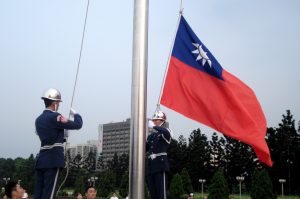By Abhijnan Rej

China’s increasing heavy-handedness toward international media, both on its soil as well as in other countries, is now, unfortunately, firmly part of its global image. The Indian media got a small taste of it yesterday when a so-called letter from the press section in the Chinese Embassy in New Delhi was circulated via social media and email, presenting “guidelines” for Indian outlets on how to cover Taiwan’s upcoming October 10 National Day. The eyebrow-raising move apparently came after a few Indian media outlets carried “advertorials” about it.
Demanding that it “stick to Indian government’s position on Taiwan question and do not violate the One-China principle,” the letter went on to add – astonishingly enough – “Taiwan shall not be referred to as a ‘country(nation)’ or ‘Republic of China’ or the leader of China’s Taiwan region as ‘President.'” As if that was not enough, the embassy made clear that non-compliance would come at a cost. By closing with “We are willing to maintain communication with media friends,” the implication was clear: ignoring the diktat could potentially mean losing access to the Chinese Embassy.
Soon after the letter was shared by an Indian journalist on Twitter, a tweet signed off by Republic of China’s Foreign Minister Joseph Wu shot back, noting that “…it looks like communist #China is hoping to march into the subcontinent by imposing censorship. #Taiwan’s Indian friends will have one reply: GET LOST!” Earlier this year, in May, two ruling Bharatiya Janata Party (BJP) members of parliament had sent congratulatory messages to President Tsai Ing-wen on her re-election, noting in a joint statement that “India and Taiwan are democratic countries, bonded by shared values of freedom, democracy and respect for human rights.”
While India does not formally recognize Taiwan as an independent country, it is important to keep in mind that New Delhi has refused to endorse the “One China” policy since 2010 in joint statements – unlike the U.S. which does so through incantations of the “Three Communiques.” In 2014, soon after Prime Minister Narendra Modi’s election for a first term, then Minister of External Affairs Sushma Swaraj pointedly nudged her counterpart Wang Yi towards a quid pro quo. “For India to agree to a one-China policy, China should reaffirm a one-India policy,” Swaraj said after her meeting with Wang. (China considers the Indian state of Arunachal Pradesh as part of Tibet.) In 2017, China rebuked India after the country permitted the visit of a Taiwanese parliamentary delegation. Further adding to this ambiguity, a 2013 India-China joint statement also omitted Tibet. India recognized Tibet as an autonomous province of China in 2003 in return of Beijing recognizing India’s sovereignty over the Himalayan state of Sikkim.
The Chinese Embassy surely knows this little bit of history, so that begs the question: Why send the “letter” in the first place, knowing very well that India’s fairly robust media will not only not comply with arbitrary demands of a foreign power, but also make said demand very well known? It is also possible now there would be a greater, reactive, media coverage of, and op-eds around, Taiwan and its National Day — thanks to China’s sadly on-brand ham-handedness.
Part of the answer lies in China’s growing concern that India is no longer willing to play by old pieties after the ongoing border standoff — whether about Tibet or Taiwan. India’s use of the secretive intelligence-controlled Special Frontier Force – staffed by ethnic Tibetans – in a military operation in Ladakh late August, as well as growing calls in certain circles of New Delhi’s strategic community that India must push forward its ties with Taiwan, certainly hasn’t escaped China’s notice, and hence the jitteriness on its part. While Taiwan’s National Day would not merit much coverage in the Indian press under normal circumstances, Beijing possibly fears Indian media paying closer attention to it given the ongoing Ladakh crisis.
But a larger part of the answer may lie with China’s inability to correctly gauge the workings of other countries, relying instead on mirror-imaging (what Edward Luttwak termed its “strategic autism”), plain old coercion or inducements. Despite visible deterioration in press freedom under Modi, India’s many news outlets are – relatively speaking, of course – free to carry stories without fear of overt state intimidation or censorship. While China has, in the past, attempted to cultivate Indian journalists through generous fellowships in Beijing, China’s coverage in leading Indian newspapers have been anything but favorable, especially in the past few years.
Quite possibly, China is interpolating from its experiences elsewhere, most notably in Italy recently, in successfully shaping foreign press opinion to India. It is rather unlikely that those tactics will work in India, not the least because anti-China sentiments in India media rule roost as the standoff in Ladakh continue.
In the meantime, stay tuned for Indian press coverage of Taiwan’s National Day on October 10.
No comments:
Post a Comment